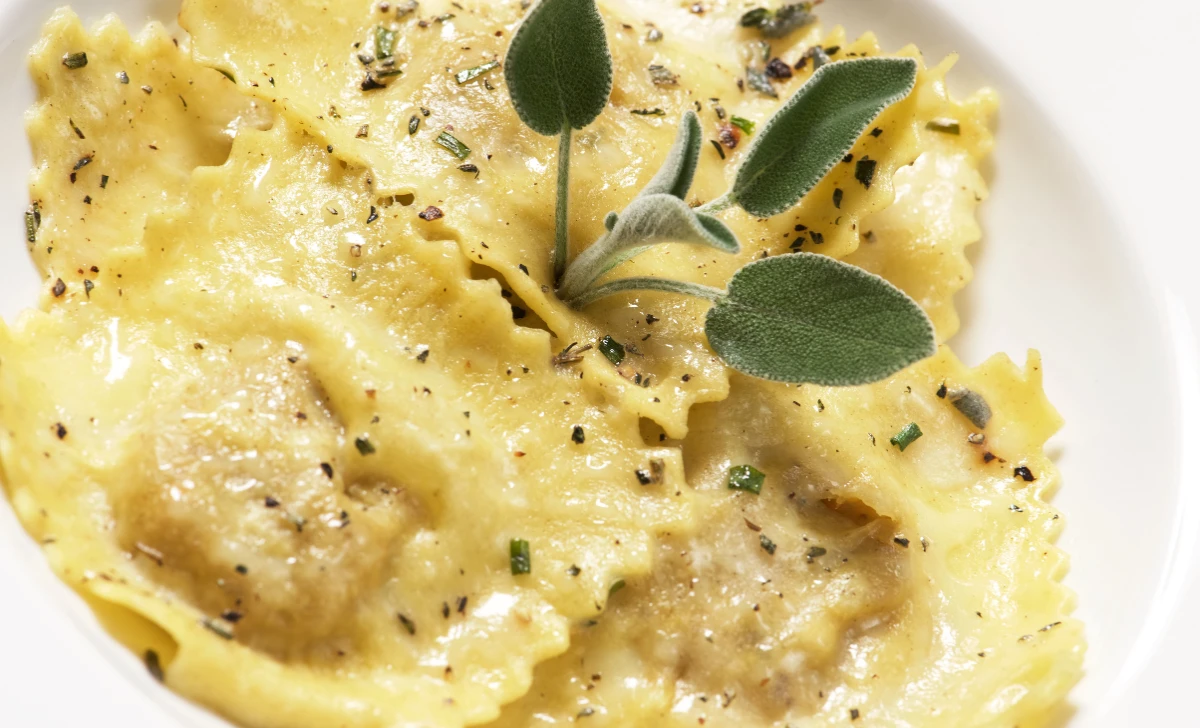Hey there, food enthusiasts! Are you ready to embark on a culinary adventure? Today, we’re diving into the world of Italian cuisine to explore the delectable and mouthwatering dish known as ravioli. If you’re a fan of pasta and all things delicious, you’re in for a treat! In this article, we’ll walk you through a step-by-step guide on how to make homemade ravioli that will leave your taste buds singing with delight. So, put on your apron, roll up your sleeves, and let’s get cooking!
[ez-toc]
History
The story of ravioli takes us back centuries, deep into the heart of Italian culinary heritage. Although the exact origins of ravioli are shrouded in mystery, its journey through time and across borders has made it a cherished dish worldwide.
Ancient Origins and Evolution:
The concept of stuffed pasta dates back to ancient times, with early civilizations such as the Greeks and Romans experimenting with various forms of filled dough. These early versions of stuffed pasta were quite different from the ravioli we know today, but they laid the foundation for its development.
It was during the Middle Ages that ravioli, as we know it, began to take shape. In medieval Italy, filled pasta dishes made with finely rolled dough became popular among the upper classes. These dishes, known as “tortelli,” “agnolotti,” and “ravioli,” varied in shape and fillings and were often served at banquets and special occasions.
The Rise of Ravioli in Italy:
The term “ravioli” is believed to have been derived from the Italian word “riavvolgere,” meaning “to wrap” or “to roll.” It is said that the original ravioli was a simple pasta pocket filled with vegetables and cheese. As time went on, the dish evolved, and regional variations emerged across Italy.
The city of Genoa in northern Italy played a significant role in the popularization of ravioli. In the 14th century, Genovese sailors and merchants traveled the Mediterranean, introducing the dish to various cultures along the way. These seafarers brought ravioli to ports in North Africa and the Middle East, where it gained further popularity and underwent further adaptations.
Ravioli Goes Global:
As Italian immigrants ventured to different parts of the world in the late 19th and early 20th centuries, they brought their culinary traditions with them. Ravioli, being a beloved Italian classic, found its way onto the tables of Italian-American families and Italian communities around the globe.
The dish’s versatility allowed it to integrate seamlessly with various culinary cultures, leading to the creation of unique ravioli variations. In the United States, for instance, ravioli became popular in Italian-American households and Italian restaurants, with new fillings and sauces being experimented with, catering to diverse tastes.
Modern-Day Ravioli: A Fusion of Tradition and Innovation:
In the present day, ravioli continues to be a symbol of Italian comfort food, both in Italy and beyond. Whether served in an authentic trattoria in Rome or a contemporary fusion restaurant in New York City, ravioli remains a beloved and versatile dish that has withstood the test of time.
Chefs and home cooks alike have embraced the culinary creativity that ravioli allows. From traditional fillings like ricotta and spinach to more adventurous combinations of seafood, fruits, and exotic cheeses, the possibilities are endless.
Time
| Step | Time Required |
|---|---|
| Making the Perfect Pasta Dough | 30 minutes |
| Preparing the Flavorful Filling | 20 minutes |
| Rolling and Shaping the Ravioli | 15 minutes |
| Filling and Sealing the Ravioli | 10 minutes |
| Cooking the Ravioli to Perfection | 5-7 minutes |
| Sauces that Complement Ravioli | 15 minutes |
| Serving and Garnishing Your Ravioli | 5 minutes |
Ingredients
| Pasta Dough | Filling |
|---|---|
| 1 cup all-purpose flour | 1 cup ricotta cheese |
| 1 large egg | 1/2 cup grated Parmesan cheese |
| A pinch of salt | 1/2 cup shredded mozzarella cheese |
| 1/2 tablespoon olive oil | 1 egg yolk |
| Water (if needed) | 1/4 teaspoon garlic powder |
| Salt and pepper to taste | |
| Cheese Lovers’ Dream | Classic Spinach and Ricotta |
| 1 cup ricotta cheese | 1 cup fresh spinach (cooked and chopped) |
| 1/2 cup grated Parmesan cheese | 1 cup ricotta cheese |
| 1/2 cup shredded mozzarella cheese | 1/4 cup grated Parmesan cheese |
| 1 egg yolk | 1 clove garlic (minced) |
| 1/4 teaspoon garlic powder | A pinch of nutmeg |
| Salt and pepper to taste | Salt and pepper to taste |
| Meaty Marvel | |
| 1/2 pound ground meat (beef, pork, or a combination) | |
| 1/4 cup onion (finely chopped) | |
| 2 cloves garlic (minced) | |
| 1/4 cup breadcrumbs | |
| 1 egg | |
| 1/4 cup grated Parmesan cheese | |
| A handful of fresh parsley (chopped) | |
| Salt and pepper to taste |
Directions
Step 1: Making the Perfect Pasta Dough
Creating the foundation of your ravioli starts with crafting the perfect pasta dough. Follow these simple steps:
Mixing the Ingredients:
In a large mixing bowl, combine 1 cup of all-purpose flour with a pinch of salt. Create a well in the center and crack 1 large egg into it. Add 1/2 tablespoon of olive oil for richness. With a fork, beat the egg while gradually incorporating the flour until a rough dough forms.
Kneading the Dough:
Transfer the dough onto a clean, floured surface. Knead the dough for about 8-10 minutes until it becomes smooth and elastic. Adjust the texture by adding a little water if it feels too dry or sprinkling some flour if it’s too sticky. Once kneaded, cover the dough with a damp cloth and let it rest for 30 minutes to relax the gluten.
Step 2: Preparing the Flavorful Filling
While the pasta dough rests, let’s prepare the delectable fillings that will tantalize your taste buds:
Cheese Lovers’ Dream:
In a mixing bowl, combine 1 cup of ricotta cheese, 1/2 cup of grated Parmesan cheese, 1/2 cup of shredded mozzarella cheese, 1 egg yolk, 1/4 teaspoon of garlic powder, and season with salt and pepper to taste. Mix until all the ingredients are well incorporated, and your cheese filling is smooth and dreamy.
Classic Spinach and Ricotta:
Cook 1 cup of fresh spinach until wilted, then finely chop it. In another bowl, combine the cooked spinach with 1 cup of ricotta cheese, 1/4 cup of grated Parmesan cheese, 1 clove of minced garlic, a pinch of nutmeg, salt, and pepper to taste. Mix everything together, and your classic filling is ready to go!
Meaty Marvel:
In a skillet, sauté 1/4 cup of finely chopped onion and 2 cloves of minced garlic until translucent. In a separate bowl, combine 1/2 pound of ground meat (beef, pork, or a combination) with 1/4 cup of breadcrumbs, 1 egg, 1/4 cup of grated Parmesan cheese, a handful of chopped fresh parsley, salt, and pepper to taste. Mix in the sautéed onions and garlic, and your meaty marvel filling is set to impress!
Step 3: Rolling and Shaping the Ravioli
Now that your dough and fillings are ready, let’s shape the ravioli:
Traditional Hand Rolling:
Divide the rested dough into two equal portions. On a floured surface, roll out one portion into a thin sheet, about 1/16 of an inch thick. Carefully place teaspoon-sized portions of your desired filling on one half of the sheet, leaving some space between each dollop. Fold the other half of the sheet over the filling, gently pressing around each mound to remove air pockets. Use a pastry wheel or knife to cut the ravioli into squares or circles.
Using a Pasta Machine:
If you have a pasta machine, use it to roll out the dough into thin sheets, following the manufacturer’s instructions. Place spoonfuls of filling on one sheet, then cover with another sheet. Press down around each mound to seal the ravioli, and use a cutter to create your desired shapes.
Ravioli Molds:
For a decorative touch, use ravioli molds to shape and seal the pasta sheets with the filling inside. Simply place one sheet on the mold, add the filling, and cover with another sheet. Press down to create individual ravioli pieces.
Step 4: Filling and Sealing the Ravioli
Now that your ravioli is shaped, it’s time to fill and seal them:
Take each ravioli piece and place a small amount of water or beaten egg along the edges. Fold the ravioli over, pressing firmly to seal the edges and encase the filling securely.
Step 5: Cooking the Ravioli to Perfection
Now that your ravioli is beautifully prepared, it’s time to cook it:
Boiling Method:
Bring a large pot of salted water to a gentle boil. Carefully drop the ravioli into the water and cook for about 5-7 minutes, or until they float to the surface. Be gentle while stirring to avoid breaking the delicate ravioli.
Sautéing Method:
Heat a skillet over medium heat and add a drizzle of olive oil or butter. Once the oil is hot, add the ravioli and sauté until they are lightly browned on each side, about 2-3 minutes.
Step 6: Sauces that Complement Ravioli
Enhance the flavors of your ravioli by pairing them with delightful sauces:
Rich and Creamy Alfredo:
Melt butter in a saucepan, add heavy cream, grated Parmesan cheese, minced garlic, and a pinch of nutmeg. Stir until the sauce is smooth and thickened.
Zesty Tomato Basil:
In a saucepan, sauté diced tomatoes, garlic, and fresh basil in olive oil until the tomatoes are soft and the flavors are infused.
Nutty Brown Butter Sage:
Melt butter in a skillet until it turns golden brown. Add chopped fresh sage leaves and a dash of salt, allowing the flavors to meld.
Step 7: Serving and Garnishing Your Ravioli
Your ravioli is now ready to be plated and served with a touch of elegance:
Plating Like a Pro:
Arrange the cooked ravioli on a plate in a visually appealing manner. Consider layering them slightly or arranging them in a spiral for a beautiful presentation.
Elevating with Fresh Herbs:
Garnish your ravioli with a sprinkle of fresh herbs like basil, parsley, or thyme. Not only do they add a pop of color, but they also enhance the overall flavor.
A Grating of Cheese:
Top your ravioli with a generous grating of Parmesan or Pecorino Romano cheese for an extra burst of savory goodness.
Equipment Required
Nutrition Information
| Nutrition Information | Per Serving (2 person serving) |
|---|---|
| Serving Size | 6-8 ravioli |
| Calories | Approximately 400-450 calories |
| Total Fat | 14-18g |
| – Saturated Fat | 7-9g |
| Cholesterol | 90-100mg |
| Sodium | 400-500mg |
| Total Carbohydrates | 48-52g |
| – Dietary Fiber | 2-3g |
| – Sugars | 2-3g |
| Protein | 18-22g |
Note: The nutrition information provided is an estimate and may vary depending on the specific ingredients and quantities used in the recipe.
Tips
- Consistency of Pasta Dough: Achieving the right consistency for your pasta dough is crucial. If it’s too dry, add a little water, a teaspoon at a time. If it’s too sticky, dust with flour. The dough should be smooth and elastic after kneading.
- Chilling the Dough: Allowing the dough to rest for 30 minutes ensures it rolls out easily and prevents it from becoming too elastic.
- Thin Pasta Sheets: Roll out your pasta dough into thin, uniform sheets to ensure a delicate texture for your ravioli. This will also prevent the pasta from being too doughy after cooking.
- Filling Quantity: Be careful not to overstuff your ravioli. Use about a teaspoon of filling for each ravioli to ensure they seal properly.
- Sealing the Edges: To prevent the filling from leaking during cooking, ensure a secure seal around the edges of each ravioli. Use a little water or beaten egg to help the edges stick together.
- Taste Test the Filling: Before sealing your ravioli, taste the filling to ensure it’s seasoned to your liking. Adjust the seasonings if needed.
- Dusting with Flour: When you lay out your filled ravioli on a tray, dust them lightly with flour to prevent sticking.
- Boiling Ravioli: If boiling your ravioli, use a large pot of generously salted water and cook them in batches to avoid overcrowding.
- Sautéing Ravioli: For a crispier texture, sauté the cooked ravioli in a pan with butter or oil until lightly browned.
- Sauce to Ravioli Ratio: When serving your ravioli with sauce, don’t drown them. A little sauce goes a long way in enhancing the flavors.
Pros & Cons
| Pros | Cons |
|---|---|
| ✅ Homemade pasta is delicious and fresher compared to store-bought options. | ❌ Preparing homemade ravioli can be time-consuming and labor-intensive. |
| ✅ Offers endless customization possibilities for fillings and sauces. | ❌ Requires some kitchen skills and experience to master the perfect pasta dough and shaping. |
| ✅ Provides an opportunity to bond with family or friends during the cooking process. | ❌ Cleaning up can be a bit messy, with flour and fillings scattered on the working surface. |
| ✅ A great way to impress guests with a visually stunning and flavorful dish. | ❌ If not sealed properly, the ravioli can open during cooking, causing filling leakage. |
| ✅ Can be made in advance and frozen for future quick and tasty meals. | ❌ If overcooked, the delicate homemade ravioli can become mushy and lose texture. |
Conclusion
Congratulations! You’ve now unlocked the secrets to creating your own scrumptious homemade ravioli—a culinary masterpiece that promises to wow your taste buds and impress your loved ones. As you’ve seen, making ravioli from scratch is a labor of love, but the end result is more than worth it.
The versatility of ravioli allows you to unleash your creativity in the kitchen, experimenting with a variety of fillings and sauces to suit your preferences and dietary requirements. Whether you’re a fan of classic cheese, savory meat, or delightful vegetarian options, the possibilities are endless.
Bond with family and friends as you gather in the kitchen, rolling out the pasta dough and crafting pockets of deliciousness together. The joy of making and sharing this delightful dish will create cherished memories that will last a lifetime.
Impress your guests at your next dinner party with a visually stunning and flavorful plate of homemade ravioli. Trust us; they won’t stop talking about it!
So, don your apron, unleash your culinary prowess, and let the magic of ravioli-making unfold. Remember, practice makes perfect, so don’t be discouraged if your first attempt isn’t flawless. With each batch, your skills will grow, and your ravioli will only get better!
Homemade ravioli is an art that combines love, passion, and a dash of creativity. Take pride in each handcrafted piece and indulge in the satisfaction of creating something truly special.
The world of ravioli awaits you, so don’t hesitate—grab your rolling pin and dive into this delightful Italian classic. Let your taste buds savor the difference of homemade goodness. Buon appetito! 🍝🇮🇹
Facts
- 🍝 Fact 1: Ravioli, the Pocket of Delight!
- 🎭 Fun Fact: In the Italian town of Piobbico, they take their love for ravioli to a whole new level! Every year, they host the “Sagra del Ciauscolo e Raviolo,” a festival celebrating not only ravioli but also “ciauscolo,” a local salami. It’s a delightful feast for both foodies and culture enthusiasts!
- 🍅 Fact 2: Ravioli, The World Traveler!
- 🥟 Fun Fact: Even astronauts can enjoy the heavenly taste of ravioli! In 1985, Italian astronaut Franco Malerba had a special treat during his space mission: a pack of ravioli specially prepared and sent to space. Talk about a cosmic culinary experience!
- 🧀 Fact 3: Ravioli’s Renaissance of Cheese!
- 🤤 Fun Fact: One of the most beloved ravioli variations is “Cacio e Pepe Ravioli,” where the pasta pocket is filled with a mixture of Pecorino Romano cheese and black pepper, resulting in a flavor explosion that makes taste buds sing with joy!
- 🍷 Fact 4: Ravioli’s Wine Pairing Adventure!
- 🍇 Fun Fact: Wine experts and sommeliers agree that the acidic, tannic nature of the wine cuts through the richness of the ravioli’s fillings, creating a harmonious dance of flavors on the palate.
- 🎨 Fact 5: Ravioli, The Artistic Masterpiece!
- 🌈 Fun Fact: In the city of Parma, Italy, a group of artists and chefs collaborated to create the “Museum of Pasta,” where ravioli is celebrated as one of the finest works of culinary art. It’s a mouthwatering exhibit you won’t want to miss!
FAQ’s
Can I use gluten-free flour to make the pasta dough for the ravioli?
Absolutely! You can substitute all-purpose flour with gluten-free all-purpose flour to make gluten-free ravioli. Ensure that the consistency of the dough is similar, and follow the same steps for rolling and shaping.
Can I make the pasta dough in advance and refrigerate it overnight?
Yes, you can! After kneading the dough, wrap it tightly in plastic wrap and refrigerate it for up to 24 hours. This allows the dough to rest and develop its flavor. Just make sure to let it come to room temperature before rolling it out.
How can I prevent my ravioli from sticking together while boiling?
To avoid sticking, make sure to generously flour the ravioli and the surface where you place them before cooking. Additionally, gently shake the pot as soon as you add the ravioli to keep them separate.
Can I freeze uncooked ravioli for later use?
Absolutely! After shaping the ravioli, place them on a baking sheet lined with parchment paper and freeze until firm. Once frozen, transfer them to an airtight container or freezer bag. Cook the frozen ravioli directly from the freezer; no need to thaw.
Can I reheat leftover cooked ravioli?
Yes, you can reheat leftover cooked ravioli. Simply heat a small amount of sauce or butter in a skillet over medium heat, add the ravioli, and cook until heated through.
Can I bake the ravioli instead of boiling or sautéing them?
Yes! For a crispy option, you can bake the ravioli. Preheat the oven to 400°F (200°C) and place the filled ravioli on a greased baking sheet. Brush them with melted butter or olive oil and bake for about 12-15 minutes, or until golden and crispy.
How long can I store cooked ravioli in the refrigerator?
Cooked ravioli can be refrigerated in an airtight container for up to 3 days. To reheat, simply microwave or reheat in a skillet with sauce.
Can I make a large batch of ravioli and freeze them uncooked for future use?
Yes, you can make a large batch of ravioli and freeze them uncooked. Make sure to place them in a single layer on a baking sheet before freezing to avoid sticking together. Once frozen, transfer to a freezer-safe bag or container.
Can I use wonton wrappers instead of making pasta dough from scratch?
Absolutely! Wonton wrappers can be used as a convenient alternative to homemade pasta dough. Simply fill the wrappers with your chosen filling and seal the edges.
Can I make dessert ravioli?
Yes, dessert ravioli is a delightful option! Sweet fillings like chocolate, fruit preserves, or Nutella work beautifully with pasta dough. Serve them with a drizzle of chocolate sauce or a dusting of powdered sugar for a delightful treat.












Leave a Review